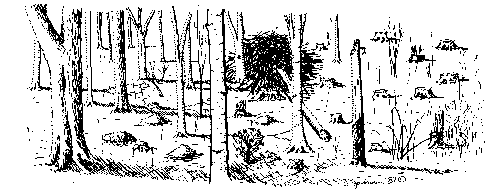Openings for Wildlife
Openings in continuous and extensive forest blocks can provide the diversity needed to sustain a greater variety of wildlife species. Such openings provide food, nesting, resting and brooding sites. Natural forest openings occur as a result of damage by insects, fire, storms and disease.
 Benefits of Wildlife Openings
Benefits of Wildlife Openings
Openings provide edge, the place where different plant communities, successional stages or stand conditions come together. The area influenced by the transition between communities is the ecotone. Ecotones are rich in both the number of wildlife species and individual animals because they provide more of the needs for a variety of wildlife than does a single vegetative type.
The vegetation in an opening furnishes forage for deer, wild turkey, cottontail rabbits, grouse, song sparrows, broad-winged hawks, flickers and other wildlife. The value of a clearing is increased if it is managed for herbaceous vegetation and shrubs which provide valuable wildlife food and cover. Clearings also attract a variety of insects which some birds are dependent on as a source of protein.
Openings in forest lands fall into two categories:
Permanent: (1) Those that will be maintained as a herbaceous opening (grass and legumes), and (2) those that will be maintained to encourage succession and native vegetation (brushy areas).
Non-permanent: (1) Those that will be cut and allowed to revert to native vegetation or planted to a more desirable tree species. Non-permanent openings are important to wildlife, but their benefits are short-lived.
Permanent herbaceous openings are the most valuable to wildlife. Grasshoppers and other insects that thrive in the grasses and forbs provide food for growing chicks, turkey poults and a variety of songbirds.
Creating and Maintaining Openings
In general, the following guidelines can be applied to forested land:
- Maintain at least two percent of the total acreage in permanent herbaceous openings.
- Maintain at least five percent of the total acreage in permanent openings, encouraging early successional native vegetation.
Openings in forested land can be developed in favorable locations through cordwood cutting, regeneration cuts or by widening existing openings along access roads and trails. The guidelines described below should be followed for creating openings:
- Openings should be no less than one-quarter acre (ideally between one-half to one acre) in size and located in an east/west direction for maximum sunlight.
- Openings should be irregular in shape, preferably long and narrow, taking on an "S" or "J" pattern. The width should be no less than one and one-half times the height of uncut adjoining trees.
- Once trees are cut, stumps and rocks should be removed by a bulldozer if a herbaceous opening is desired. This allows for site preparation for seeding and periodic future maintenance.
- Locate openings close to early successional stage conifer patches to provide valuable wildlife cover nearby.
Openings that will be maintained for herbaceous growth should be seeded to provide optimum wildlife food sources, and mowed every two to three years to discourage the natural invasion of woody plants. Early successional openings should be mowed (brush-hogged) every four to six years.
Site preparation for seeding should be as follows: (1) disking, (2) liming, (3) fertilizing, (4) disking again and (5) seeding. Soils can be tested for lime and fertilizer requirements through a local Natural Resource Conservation Service office or University Extension Service. Commonly used seeds include ladino clover, birds foot trefoil, rye grass, millet, sorghum, buckwheat and various conservation mixes. In Connecticut, unseeded openings generally revert back to blackberry, pokeweed, sumac and elderberry.
Plantings for Food and Cover
Shrubs, such as gray dogwood, honeysuckle and highbush cranberry, can be planted and encouraged at the edge of forest land openings. These shrubs provide valuable food and cover and do not require annual maintenance, except for occasional fertilizing and cutting of undesirable plants around the plantings.
Coniferous cover can be incorporated into opening schemes. Once a conifer has reached 10 to 12 feet, it may be cut to about four feet to provide heavy cover close to the ground.
Glossary
Community -- a group of one or more populations of plants and animals in a common spatial arrangement.
Conifer -- includes a wide range of trees, mostly evergreens that bear cones and have needle-shaped or scale-like leaves.
Forage -- vegetation used for food by wildlife.
Forb -- any herbaceous plant species other than those in the grass, sedge and rush families.
Herbaceous -- a plant that grows from seeds or perennial roots rather than from woody, above-ground parts.
Regeneration cut -- any removal of trees intended to assist regeneration (renewal of the tree crop) already present or to make regeneration possible.
Stand -- a plant community, particularly of trees, sufficiently uniform in composition, constitution, age, spatial arrangement, or condition to be distinguishable from adjacent communities.
Succession -- the changes in vegetation and animal life that take place as the plant community evolves from bare ground to the climax stage (e.g., old growth forest).
 The Technical Assistance
Informational Series is 75 percent funded by Federal Aid to Wildlife Restoration -
Pittman-Robertson (P-R) Program. The P-R Program provides funding through an excise tax on
the sale of sporting firearms, ammunition, and archery equipment. The remaining 25 percent
of the funding is matched by the Connecticut Wildlife Division. (rev. 10/00)
The Technical Assistance
Informational Series is 75 percent funded by Federal Aid to Wildlife Restoration -
Pittman-Robertson (P-R) Program. The P-R Program provides funding through an excise tax on
the sale of sporting firearms, ammunition, and archery equipment. The remaining 25 percent
of the funding is matched by the Connecticut Wildlife Division. (rev. 10/00)

